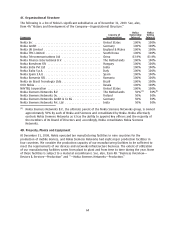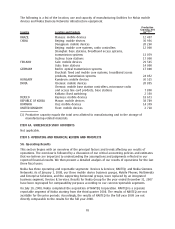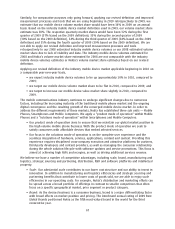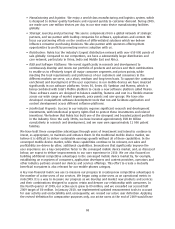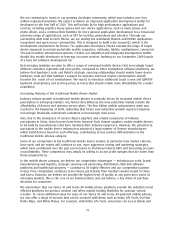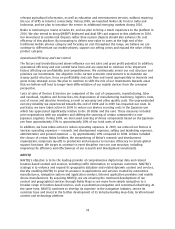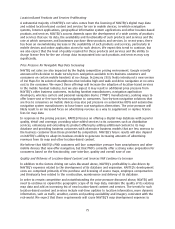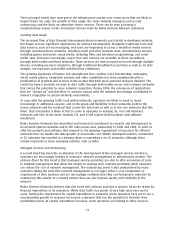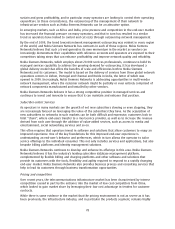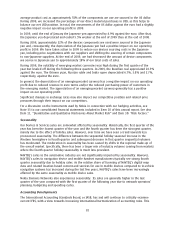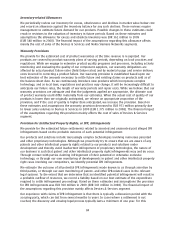Nokia 2009 Annual Report Download - page 76
Download and view the complete annual report
Please find page 76 of the 2009 Nokia annual report below. You can navigate through the pages in the report by either clicking on the pages listed below, or by using the keyword search tool below to find specific information within the annual report.relevant agricultural information, as well as education and entertainment services, without requiring
the use of GPRS or Internet connectivity. During 2009, we launched Nokia Life Tools in India and
Indonesia, and we plan to introduce the service to additional emerging markets during 2010.
Nokia is continuing to invest in Series 40, and we plan to bring a touch experience to the platform in
2010. We also intend to bring QWERTY keyboard and dual SIM card support to this platform in 2010.
Our movement to commercial chipsets rather than custom chipsets should also enhance the cost
efficiency of this platform. By innovating to deliver new value to users at the high end of the
traditional mobile phones category and focusing on cost throughout the range, we believe we can
continue to differentiate our mobile phones, support our selling prices and expand the value of this
product category.
Operational Efficiency and Cost Control
The factors and trends discussed above influence our net sales and gross profit potential. In addition,
operational efficiency and cost control have been and are expected to continue to be important
factors affecting our profitability and competitiveness. We continuously assess our cost structure and
prioritize our investments. Our objective in the current economic environment is to maintain our
strong capital structure, focus on profitability and cash flow and invest appropriately to innovate and
grow in key strategic areas. We plan to continue to shift the mix of our investments towards areas
that we believe will lead to longerterm differentiation of our mobile devices from the consumer
perspective.
Costs of sales of Devices & Services are comprised of the cost of components, manufacturing, labor
and overhead, royalties and license fees, the depreciation of manufacturing machinery, logistics costs,
cost of excess and obsolete inventory, as well as warranty and other quality costs. The unprecedented
currency volatility we experienced towards the end of 2008 and in 2009 has impacted our costs. In
particular, we have taken action in 2009 to reduce our devices sourcing costs in the Japanese yen
which has appreciated significantly relative to the US dollar and the euro. These measures included
price negotiations with our suppliers and shifting the sourcing of certain components to non
Japanese suppliers. During 2009, we decreased sourcing of device components based on the Japanese
yen from approximately 25% to approximately 18% of our total costs of sales.
In addition, we have taken action to reduce operating expenses. In 2009, we reduced our Devices &
Services operating expenses — research and development expenses, selling and marketing expenses,
administrative and general expenses — by approximately 10% compared to 2008. Actions included
the closure of certain Nokia facilities, the streamlining of Nokia’s research and development
organization, temporary layoffs in production and measures to increase efficiency in certain global
support functions. We target to continue to exert discipline over our cost structure, including
improving the efficiency and effectiveness of our research and development investments.
NAVTEQ
NAVTEQ’s objective is to be the leading provider of comprehensive digital map data and related
locationbased content and services, including traffic information, to corporate customers. NAVTEQ’s
strategy is to enhance and expand its geographic database and related dynamic content and services,
thereby enabling NAVTEQ to grow its presence in applications and services created by automotive
manufacturers, navigation system and application vendors, Internet application providers and mobile
device manufacturers. By acquiring NAVTEQ, we are ensuring the continued development of our
context and geographical services through Nokia Maps as we move from simple navigation to a
broader range of locationbased services, such as pedestrian navigation and contextual advertising. At
the same time, NAVTEQ continues to develop its expertise in the navigation industry, service its
customer base and invest in the further development of its industryleading map data, locationbased
content and technology platform.
74


